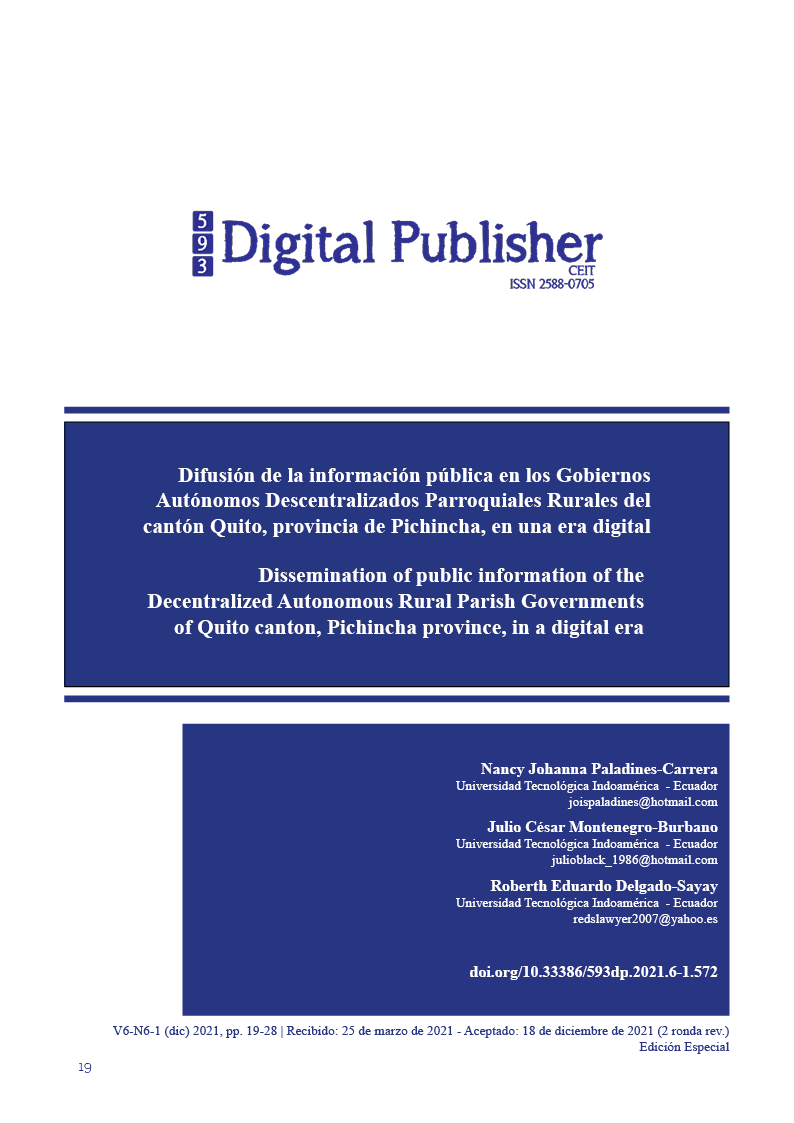Dissemination of public information of the Decentralized Autonomous Rural Parish Governments of Quito canton, Pichincha province, in a digital era
Main Article Content
Abstract
In a digital age, the modernization of the State is a challenge that must be carried out in an imperative way; without these advances, the effective exercise of fundamental rights such as access to public information, citizen participation and social control, will continue to be a utopia; the research provides a descriptive analytical analysis of compliance with the mandatory (minimum) requirements established by the regulations regarding the dissemination of public information on the web pages of each of the Autonomous Decentralized Parish Governments of Quito canton, Pichincha province, based on the study of article 7 Organic Law of Transparency and Access to Public Information (OLTAPI) as well as the Constitution of Ecuador, which allows supporting the data collected in the investigation.
The data evidenced by the analysis presents a critical panorama, considering that eighty-five percent of the governments in the study do not keep their population informed of the management they carry out, thus concluding that the lack of transparency continues to be a problem that technology does not supply.
This research makes constitutional and legal emphasis and the critical implementation of access to public information in the management carried out by the decentralized autonomous governments of rural parishes in Quito canton, Pichincha province, as part of the “Project implementation of strategies for transparency and anti-corruption in Pichincha Province GAD; Quito GAD and its rural parish GADs 2020–2021” carried out with the participation of the students of the Sixth Semester of Law, face-to-face and blended modalities.
Downloads
Article Details

This work is licensed under a Creative Commons Attribution-NonCommercial-ShareAlike 4.0 International License.
1. Derechos de autor
Las obras que se publican en 593 Digital Publisher CEIT están sujetas a los siguientes términos:
1.1. 593 Digital Publisher CEIT, conserva los derechos patrimoniales (copyright) de las obras publicadas, favorece y permite la reutilización de las mismas bajo la licencia Licencia Creative Commons 4.0 de Reconocimiento-NoComercial-CompartirIgual 4.0, por lo cual se pueden copiar, usar, difundir, transmitir y exponer públicamente, siempre que:
1.1.a. Se cite la autoría y fuente original de su publicación (revista, editorial, URL).
1.1.b. No se usen para fines comerciales u onerosos.
1.1.c. Se mencione la existencia y especificaciones de esta licencia de uso.
References
Asamblea General de los Estados Américanos. (07 de junio de 2005). Organización de Estado Américanos. Obtenido de http://www.oas.org/consejo/sp/AG/AG43ordinaria.asp
Castell, M. (2010). El Impacto de internet en la sociedad: una perspectiva global. Obtenido de https://www.bbvaopenmind.com/articulos/el-impacto-de-internet-en-la-sociedad-una-perspectiva-global/
Codificación de Parámetros Técnicos para el Cumplimiento de las Obligaciones de Trasparencia Activa Establecidas en el Art. 7 de la Ley Orgánica de Transparencia y Acceso a la Información Pública – LOTAIP. (2017). Registro Oficial Suplemento N° 433.
Código Orgánico de Organización Territorial Autonomía y Descentralización. (2010). Quito: Registro Oficial Suplemento N° 303.
Congreso Nacional. (2004). LEY ORGÁNICA DE TRANSPARENCIA Y ACCESO A LA INFORMACIÓN PÚBLICA. QUITO: REGISTRO OFICIAL SUPLEMENTO 337.
Constitución de la República del Ecuador. (2008). Registro Oficial Suplemento N° 449.
Correa , J. (2017). Universidad Técnica de Machala. Obtenido de Acceso abierto a la información: Garantías y retos en el Ecuador: http://investigacion.utmachala.edu.ec/proceedings/index.php/utmach/article/download/173/146
Corte Consitucional de la República de Colombia. (11 de febrero de 2015). Sentencia C-274/13. Obtenido de https://www.corteconstitucional.gov.co/relatoria/2013/c-274-13.htm
Corte Consitucional del Ecuador, Sentencia N°013-16 (Corte Consitucional del Ecuador 13 de enero de 2016).
Defensoría del Pueblo. (2015). Guía para el Cumplimiento de las Entidades Obligadas on la LOTAIP. Dirección Nacional de Transparencia y Acceso a la Información Pública Diagramación y Diseño: Dirección Nacional de Comunicación. Obtenido de https://www.dpe.gob.ec/wp-content/dpedocumentoslotaip/presentacioninformeslotaip2016/Guialotaiptransparenciaactivaypasiva.pdf
Instituto Nacional de Estadística y Censos. (2020). Tecnologías de la Información y Comunicación. Obtenido de https://www.ecuadorencifras.gob.ec/tecnologias-de-la-informacion-y-comunicacion-tic/
Ley Orgánica de Transparencia y Acceso a la Información Pública. (2004). Quito: Registro Oficial Suplemento N°337.
Ley Orgánica de Transparencia y Acceso a la Información Pública. LOTAIP. (2004). Quito: Lexis.
Pont, E. (08 de enero de 2021). La Vanguardia. Obtenido de Vivir sin acceso a internet: https://www.lavanguardia.com/vida/junior-report/20190513/462140060359/brecha-digital-desigualdad-acceso-internet.html
Spano, P. (2016). El principio de transparencia de la gestión pública en el marco de la teoría del bueno gobierno y la buena administración. Revista Digital de la Asociación Argentina de Derecho Administrativo, 237.




